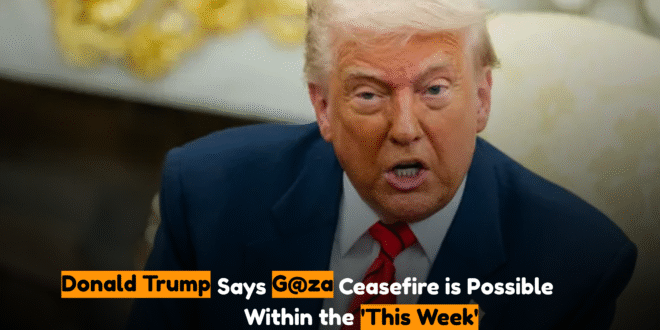Trump’s Ceasefire Declaration: “Within This Week”
In the past 24 hours, the biggest headline came as Donald Trump stated on June 27, 2025, from the Oval Office that a ceasefire in Gaza could happen within the week. He said, “I think it’s close. I just spoke to some of the people involved … within the next week we’re going to get a ceasefire.”
He further clarified that negotiations between Israel and Hamas are actively underway. While Hamas has hinted at the release of some hostages, Israel insists that a ceasefire is only possible if Hamas is fully disarmed. This statement was echoed by several international media outlets, which confirmed the potential progress in talks
Current Status of Negotiations and Regional Context
Trump’s statement came during a press interaction, though he did not reveal whom he had spoken with. According to some media sources, no official ceasefire deal has been finalized yet. His optimism seems more like a political signal than a concrete development.
On the ground in Gaza, the sentiment is largely skeptical. Many Palestinians believe they’ve heard such promises before with no real change. This ongoing cycle has fueled frustration and deepened the sense of distrust among civilians.
Impact of the Israel-Iran Ceasefire
Trump also referenced the recent ceasefire between Israel and Iran, stating that it has helped create diplomatic momentum for a possible resolution in Gaza. He mentioned that international stakeholders are in daily communication to help bring about an end to the conflict.
This regional ceasefire is considered significant because it has opened a window for broader peace talks, including the Gaza situation.
Hostages, Disarmament, and Deal-Breakers
One of the major sticking points in the negotiations is the issue of hostage exchange and disarmament. Reports state that a U.S. envoy had proposed a 60-day ceasefire plan, which included the release of hostages and Palestinian prisoners. However, the deal fell through due to Hamas placing specific political conditions that Israel found unacceptable.
Israel maintains that there can be no lasting ceasefire until Hamas is completely disarmed and dismantled.
Skepticism in Gaza and the Worsening Humanitarian Crisis
Inside Gaza, civilians remain in a dire situation. Many people express exhaustion over political promises that never materialize into real relief. Israel has also issued evacuation orders in northern Gaza, worsening the humanitarian crisis.
Residents say that unless there is visible action on the ground, political optimism does not mean much to them.
Political Dimensions: Trump, Netanyahu, and Trial Delay
Donald Trump also addressed the ongoing corruption trial of Israeli Prime Minister Netanyahu, suggesting that legal proceedings should be paused to avoid disrupting ceasefire talks. Netanyahu’s hearings have indeed been postponed this week, which could be a strategic move to facilitate peace negotiations.
This political angle matters because Netanyahu’s decisions directly influence Israel’s military policy in Gaza.
What Lies Ahead?
-
Momentum and Pressure: Trump’s optimism reflects international pressure, but negotiations have not been finalized.
-
Key Conditions: Hostage exchanges and Hamas disarmament remain major obstacles.
-
Humanitarian Emergency: The worsening situation in Gaza highlights the urgent need for a ceasefire.
-
Regional Influence: The Iran ceasefire has opened diplomatic doors, but Israel’s hardline stance remains a hurdle.
Conclusion
Based on the past 24 hours of news coverage, Trump’s statement that a ceasefire could happen “within this week” offers a glimmer of hope, but the situation on the ground is far more complicated. Skepticism among Gaza’s residents, unresolved hostage issues, continued evacuations, and political entanglements all challenge this optimism.
If international mediators, Israel, Hamas, and regional powers can reach a workable consensus, this week might mark a pivotal moment in resolving the Gaza conflict.




